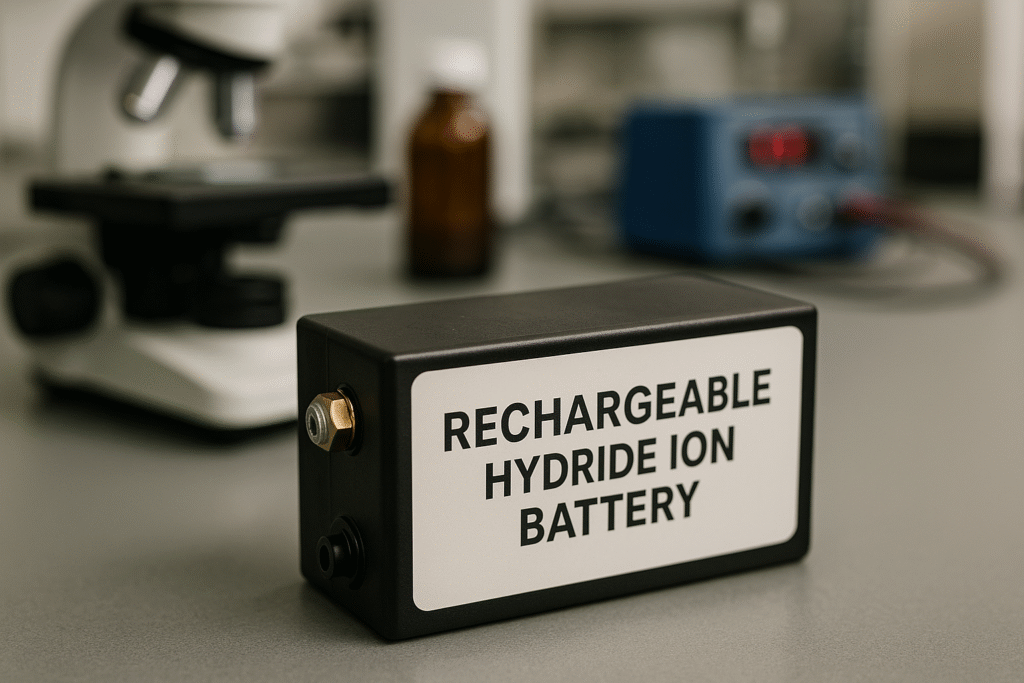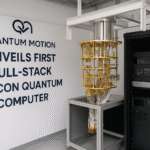By Harshit | 1 October 2025 | Dalian, China | 09:30 EDT
Introduction
In a landmark achievement in energy storage research, scientists at the Dalian Institute of Chemical Physics (DICP), Chinese Academy of Sciences, have built the world’s first rechargeable hydride ion (H⁻) battery. The work, led by Professor Ping Chen and published in Nature, demonstrates a prototype system that achieves both stability and room-temperature operation—two requirements that have hindered progress in hydride-based electrochemical devices for decades.
Hydride ions, composed of hydrogen atoms with an extra electron, are attractive as charge carriers due to their exceptionally low mass and high redox potential. These features could enable batteries with greater energy density, efficiency, and safety compared to conventional lithium-ion technology. Until now, however, no known electrolyte material combined fast ion mobility with thermal stability and electrode compatibility.
Core–Shell Electrolyte Breakthrough
The breakthrough comes from a heterojunction-inspired design. Chen’s team created a core–shell composite hydride designated 3CeH3@BaH2, in which a thin shell of barium hydride (BaH2) encapsulates a core of cerium hydride (CeH3).
- CeH3 is known for its high hydride ion conductivity.
- BaH2 provides the structural and chemical stability required to suppress decomposition.
By integrating these two properties into a single engineered material, the researchers achieved rapid hydride ion conduction at room temperature with strong resistance to both thermal stress and electrochemical breakdown.
This design resolves a fundamental limitation that had previously restricted hydride ion systems to either low conductivity or unstable operation.
Prototype Battery Assembly
Using this electrolyte, the team constructed the first all-solid-state rechargeable hydride ion battery. The device employed:
- Anode: CeH2
- Electrolyte: 3CeH3@BaH2
- Cathode: NaAlH4, a widely studied hydrogen storage compound
Electrochemical testing revealed impressive performance metrics:
- Initial discharge capacity: 984 milliampere hours per gram (mAh/g) at room temperature
- Retained capacity: 402 mAh/g after 20 full cycles
- Operating voltage: 1.9 volts
In a practical demonstration, the prototype successfully powered a yellow light-emitting diode (LED) lamp, confirming its ability to deliver usable current in an integrated circuit.
Scientific and Technological Significance
The successful operation of this device marks the first room-temperature, all-solid-state hydride ion battery reported in scientific literature. The implications are considerable:
- Safety: Unlike lithium-ion systems, which suffer from dendrite formation leading to potential short circuits and thermal runaway, hydrogen-based charge carriers eliminate this issue.
- Energy Storage Potential: Hydride ions’ low mass could eventually support devices with higher specific capacities than lithium or sodium ion counterparts.
- Material Tunability: Hydride-based compounds can be engineered to balance conductivity, stability, and electrode compatibility, offering a versatile platform for optimization.
- Sustainability: Hydrogen is the most abundant element in the universe, making hydride-based batteries a potentially scalable solution for future clean energy systems.
Remaining Challenges
While groundbreaking, the technology is still in its infancy. The prototype displayed capacity fading after only 20 cycles, indicating the need for further improvements in cathode stability and interface engineering. Additionally, the device’s operating voltage of 1.9 V is lower than commercial lithium-ion cells, which typically exceed 3.6 V.
Scaling production, improving energy density, and extending cycle life will be critical steps before hydride ion batteries can compete in consumer electronics, electric vehicles, or grid-level storage.
Historical Context
Hydrogen has long been studied as a potential energy vector. Hydride compounds, in particular, attracted interest for hydrogen storage in fuel cells. However, their direct use in batteries has been hindered by difficulties in controlling ion mobility and preventing chemical degradation.
The DICP team’s use of a heterojunction core–shell electrolyte represents a novel approach that merges insights from solid-state physics, materials chemistry, and electrochemistry. This interdisciplinary strategy may also inform the design of future electrolytes for other ion systems.
Outlook
The demonstration of a rechargeable hydride ion battery at room temperature provides proof of concept for a new class of electrochemical energy storage devices. With further research into electrode materials, interfaces, and large-scale manufacturing, hydride ion batteries could become competitive with or complementary to lithium-ion technology.
Professor Chen’s group emphasized that the discovery opens the door to a “completely new route” for safe, efficient, and sustainable energy storage and conversion. If successfully developed, such systems could play a pivotal role in stabilizing renewable energy grids, electrifying transport, and reducing global dependence on fossil fuels.
Conclusion
For decades, hydride ions were considered promising yet impractical charge carriers. By engineering a core–shell electrolyte that combines conductivity with stability, researchers have taken a decisive step forward. Though many challenges remain, this achievement establishes a foundation for a new generation of hydrogen-based solid-state batteries, aligning scientific innovation with the urgent global demand for sustainable energy technologies.







